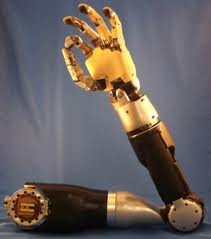
When the Nintendo Wii first came out, I was baffled. I kept trying to play it like any other video game, using just my thumbs. You mean, I have to actually turn the joystick like it’s a wheel? Swing it like a tennis racket? It just didn’t compute. While the Wii is novel, high-tech, and fun, I have to admit that I miss the Atari’s single-button action and the resulting palm blister.
So the notion of brain implants, the subject of last week’s post, makes me a bit woozy.
And last week’s post, which focused on the cognitive enhancements rather than the physical ones, doesn’t begin to cover everything.
Researchers are working on brain implants that not only improve the brain’s functioning, but that allow people to move things. With their minds. Like in a Stephen King novel, or like the Telepaths on Babylon 5.
Scientists at Intel are currently working on correlating brain patterns with actual thoughts by studying brain scans. They hope to develop brain implants by 2020; they want us to be able to control our gadgets with our brains as soon as possible. Imagine not needing a mouse at all, or a remote, or any other medium that allows us to control our machines. Imagine whipping up a milkshake while lounging on the couch.
Turns out we can control even bigger things with our minds.
Toyota has developed a brain-controlled wheelchair. Perhaps even more awesome is Honda’s brain-machine interface, which allows a person to communicate with Asimo, the world’s most advanced robot. Hooked into the interface, you could send telepathic signals to Asimo by imagining yourself doing something. See the demo here.
Asimo can mimic the gesture, or do the movement for you; if nothing else you’d have the world’s most advanced backscratcher. I wonder if there are limits to what Asimo would do–it’d be an interesting test of whether machines can think or learn.
Scientists at the University of Michigan have invented the BioBolt, which transmits brainwaves to a computer or other device using the body’s skin, instead of sitting directly in the skull like most neural implants. Ultimately, scientists hope that this technology will allow patients to reactivate paralyzed limbs by thinking.
Implants that stimulate neural nerves in the brain’s cortex or hippocampus could allow people to tele-operate prosthetics. At the University of Pittsburgh, scientists implanted computer chips into the brains of macaque monkeys, which allowed the monkeys to control prosthetic arms. DARPA, the Defense Advanced Research Projects Agency, has recently begun a program to develop brain-controlled prosthetic limbs in the next five years. Currently, neural interfaces last only around two years, so one of DARPA’s challenges is to create neural-prosthetic connections that last a lifetime.
And, of course, scientists at MIT can turn brainwaves into video game maneuvers. While playing the popular game Doom, subjects controlled movement with the joystick but could shoot the enemy with their minds. Whatever happens, we do know this: Atari thumb will go the way of polio and the Woolly Mammoth. Nostalgia, however, won’t.

Love your blog. You really got me thinking about scientific possibilities and probabilities in new ways. Previously, I felt that humans should be very careful about what they choose to develop, especially when it comes to scientific ideas like brain implants. However, this blog has helped me reexamine my views and open up and relax a bit about scientific advancements. I like the idea of brain-controlled wheelchairs and especially love the idea of brain-controlled prosthetics.
Elaine Sangiolo
Bookmarketing Manager for Cathedral of Dreams by Terry Persun and A Kingdom’s Possession by Nicole Persun
Booktrope Publishing
http://www.booktrope.com
http://www.booktropepublishing.com